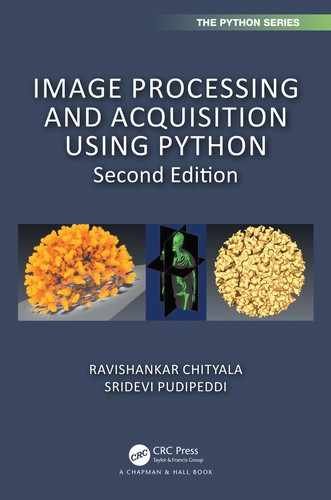This book is meant for upper level undergraduates, graduate students and researchers in various disciplines in science, technology and mathematics. The book covers both image acquisition and image processing. The knowledge of image acquisition will help readers to perform experiments more effectively and cost efficiently. The knowledge of image processing will help the reader to analyze and measure accurately. Through this book, the concepts of image processing will become ingrained using examples written using Python, long recognized as one of the easiest languages for non-programmers to learn.
Python is a good choice for teaching image processing because:
1.It is freely available and open source. Since it is a free software, all students will have access to it without any restriction.
2.It provides pre-packed installations available for all major platforms at no cost.
3.It is the high-level language of choice for scientists and engineers.
4.It is recognized as perhaps the easiest language to learn for non-programmers.
Due to new developments in imaging technology as well as the scientific need for higher resolution images, the image data sets are getting larger every year. Such large data sets can be analyzed quickly using a large number of computers. Closed source software like MATLAB® cannot be scaled to a large number of computers as the licensing cost is high. On the other hand, Python, being free and open-source software, can be scaled to thousands of computers at no cost. For these reasons, we strongly believe the future need for image processing for all students can be met using Python.
The book consists of three parts: Python programming, image processing, and image acquisition. Each of these parts consists of multiple chapters. The parts are self-contained. Hence, a user well versed in Python programming can skip Part I and read only Parts II and III. Each chapter contains many examples, detailed derivations, and working Python examples of the techniques discussed within. The chapters are also interspersed with practical tips on image acquisition and processing. The end of every chapter contains a summary of the important points discussed and a list of exercise problems to cement the reader’s understanding.
Part I consists of introduction to Python, Python modules, reading and writing images using Python, and an introduction to images. Readers can skip or skim this part if they are already familiar with the material. This part is a refresher and readers will be directed to other resources as applicable.
In Part II, we discuss image processing and computer vision algorithms. The various chapters discuss pre- and post-processing using filters, affine transformation, segmentation, morphological operations, image measurements, neural network and convolutional neural network.
In Part III, we discuss image acquisition using various modalities such as X-ray, Computed Tomography (CT), Magnetic Resonance Imaging (MRI), light microscopy and electron microscopy. These modalities cover most of the common image acquisition methods used currently by researchers in academia and industry.
Details about exercises
The Python programming and image processing parts of the book contain exercises that test the reader’s skills in Python programming, image processing, and integration of the two. Solutions to odd-numbered problems, example programs and images are available at https://github.com/zenr/IMAUP-book-ed-2.
